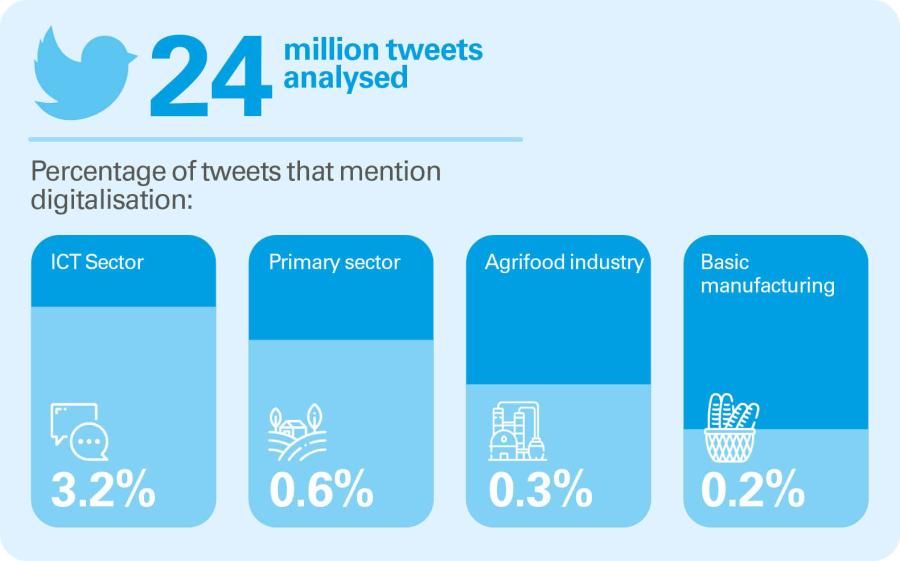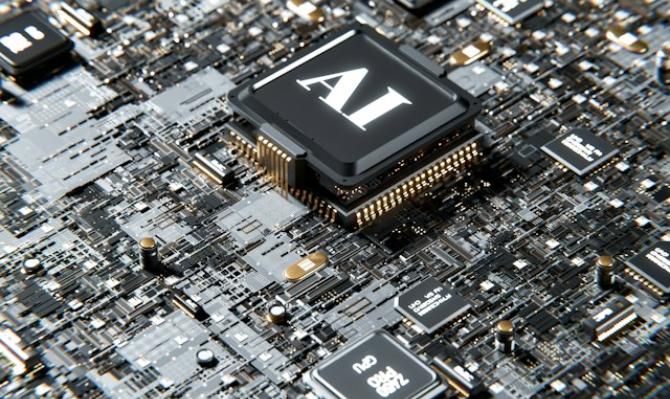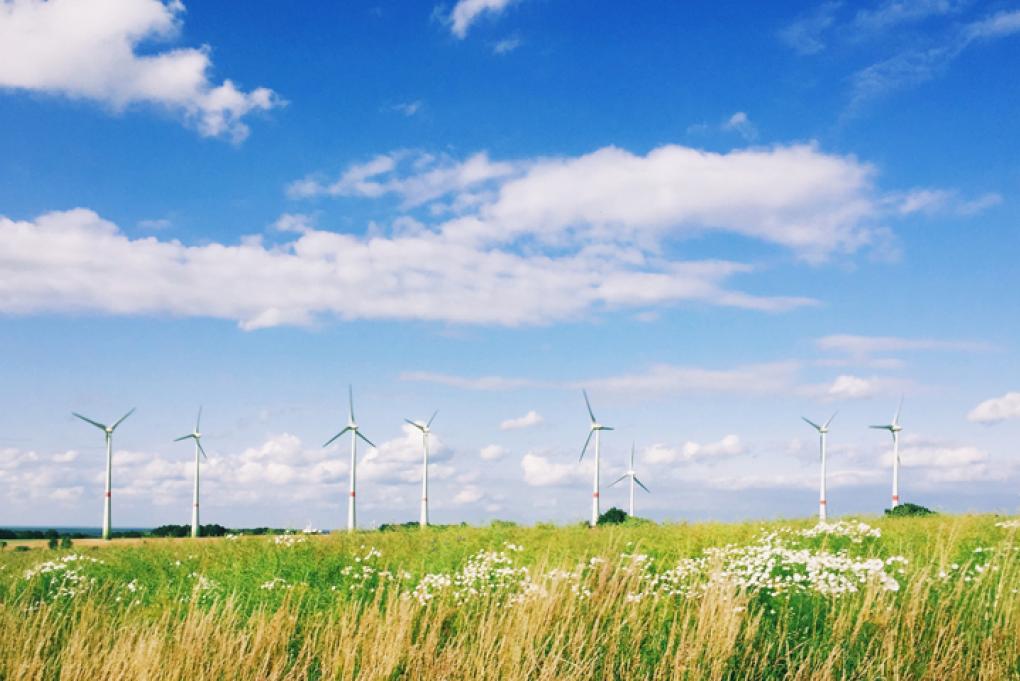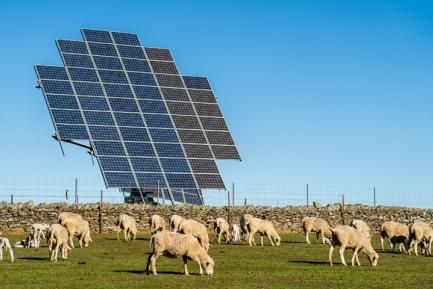Digitalisation of the agrifood sector: what does Twitter tell us?
Technology is advancing at a frenetic pace and offers the agrifood chain a large number of opportunities to make its production more efficient and sustainable. Moreover, the arrival of COVID-19 has shown that the most digitalised companies were able to continue their activities more readily than the rest. In this article we examine the degree of popularity of the different digital technologies used in the primary sector and agrifood industry based on a text analysis of over 2 million tweets on Twitter. All these technologies are essential to create a connected ecosystem that will make up the Food Chain 4.0 of the future.

The unexpected arrival of the pandemic has shown that the most digitalised companies were more prepared to adapt to the new situation and were able to continue to operate much more smoothly than the rest. There is no doubt that, in this new environment, the digital transformation of companies is now unavoidable in order to boost their competitiveness.
Big data, robotics, the internet of things and blockchain are just some examples of the new digital technologies gradually being adapted by firms, particularly in the agrifood sector. Technology is advancing at a frenetic pace and is offering the agrifood chain a large number of opportunities to produce more efficiently and sustainably. However, statistical information on the degree to which such technologies have been taken up, and the most comprehensive official statistical source1, does not provide information on the primary sector. Below we present a novel analysis of the «popularity» of new digital technologies in the agrifood sector based on data from Twitter.
- 1. Survey on the use of information and communication technologies (ICT) and e-commerce in companies, compiled by the National Statistics Institute.
Data from Twitter can be extremely valuable in detecting new trends as it allows us to analyse the popularity of certain terms according to how frequently they appear in tweets. However, it is true that «talking about something» is not the same as successfully implementing the various digital technologies in a company's recurring operations. For this reason the results presented below should be interpreted simply as an indication of new trends that may be taking root in agrifood companies.
are in the agrifood sector according to how often they are mentioned in tweets.
For this study, data was processed from over 24 million tweets sent by individual users and digital media during the period 2017-2019. Among these, 2 million corresponded to the agrifood sector. Using natural language processing techniques, the tweets were categorised according to mentions of different digital technologies and to the business sector.2 The key to obtaining relevant data from social media is to first define «seed» words or phrases to identify texts corresponding to each of the business sectors, as well as «seed» words or phrases related to the different digital technologies of interest.3 Using a machine-learning algorithm, other words and phrases related to the concept in question that were not initially included were also identified, thus broadening the spectrum of texts analysed. At this stage, it is important to carefully screen for polysemous words (i.e. those that have more than one meaning, such as the word «reserva» in Spanish, which can be used to refer to a hotel booking as well as an aged wine).
- 2. This analysis was carried out in collaboration with Citibeats, a company specialising in unstructured natural language processing.
- 3. For example, the «seed» woods and phrases used to identify big data were: analytics, arquitectura de sistemas (system architecture), data mining, database, inteligencia empresarial (business intelligence), Python and SQL, among others (as well as the term big data per se).
To assess the agrifood sector's degree of digitalisation according to data from Twitter, we first need to know how common tweets about digitalisation are in other business sectors. The most digitalised industry according to our analysis is the information and communication technologies (ICT) sector: 3.2% of the sector's tweets contain terms related to digitalisation, a result that is not surprising given the very nature of the industry. Next comes finance and insurance with 2.7% of the tweets.
This percentage is obviously lower in the primary sector at 0.6% but it is similar to the 0.7% for professional, scientific and technical activities. In the case of the agrifood industry, the percentage of tweets on digitalisation is only 0.3%, very close to the basic manufacturing sector (which includes the textile, wood, paper and graphic arts industries), with the lowest percentage among the sectors analysed, 0.2%.

The wealth of data obtained from Twitter allow us to identify the most popular digital tools in each business sector according to how frequently they are mentioned in the tweets examined. According to our analysis, a large proportion of the primary sector's tweets about digitalisation tend to include issues related to big data (45% of all tweets about digitalisation). One clear example of the application of big data in the sector can be found in «precision agriculture» techniques which require large amounts of data to be analysed to optimise decisions and thereby increase production and, in turn, ensure sustainability. These techniques are used, for instance, to calculate the irrigation requirements of crops by taking into account climatic conditions (sunlight, wind, temperature and relative humidity) and crop characteristics (species, state of development, planting density, etc.). To carry out this calculation, real-time updated meteorological data, a large computing capacity and fast data transmission speeds are all required for an automatic irrigation system to be properly adjusted. This technology helps to use water more efficiently, a highly relevant aspect in areas with a Mediterranean climate that are extremely vulnerable to climate change and where water is in short supply.
indispensable for advancing the application of precision agriculture techniques and smart automated farming.
Other popular technologies in the primary sector are the internet of things (16% of tweets) and robotics, including drones (10% of tweets). The new digital technologies promise to revolutionise the field of agriculture and stockbreeding by the middle of this century, the same as the mechanisation of farming in the xxi century. Agricultural Machinery 4.0 (which is closer to the robots in science fiction films than to the tractors we are used to seeing on all farms in the country) helps to increase productivity whilst also improving working conditions in the field. This trend towards more automated agricultural tasks has become stronger in the wake of the coronavirus pandemic, as the difficulty in recruiting seasonal workers due to international mobility restrictions has led to increased interest in robotics and agricultural automation. In fact, companies that manufacture robots for agriculture have seen a sharp increase in orders, such as robots that pick strawberries while removing mould with ultraviolet light.14
The use of drones warrants particular attention as this has grown exponentially in recent years and applications are increasingly widespread: from the early detection of pests and the aerial inspection of large areas of crops to locating wild boar with heat-sensitive cameras to prevent the spread of African swine fever to domestic pigs.5
The popularity of various digital technologies in the agrifood sector

Blockchain is the technology that stands out most in the food sector (30% of the total number of tweets on the sector's digitalisation) and this comes as no surprise as it has many different applications for the food and beverage industry. Producing a chain of unalterable, reliable records, blockchain makes it possible to guarantee the complete traceability of products throughout all the links in the food chain. Simply scanning a QR code provides access to all the data regarding the origin, production method, veterinary treatments received, ingredients used, etc. A large number of agrifood companies are already experimenting with blockchain as it offers clear benefits in terms of transparency regarding origin, product quality and food safety, aspects that are increasingly valued by consumers. Blockchain technology is also being used to limit food waste, another essential challenge for the sector.
making them traceable throughout the links in the food chain.
There are some digital technologies that are not very popular across all economic sectors, perhaps because they have a more limited or specific range of application. These are technologies that, despite having a low percentage of tweets in absolute terms according to our study, may be relatively popular for a particular sector compared with the rest.
To detect such cases, we have calculated a new metric, namely a concentration index which takes into account the relative popularity of technologies in a sector compared with the rest of the sectors.6 By using this methodology, we have found that the primary sector continues to stand out in terms of big data. Specifically, the primary sector concentrates 9.2% of the total number of tweets mentioning big data made by all sectors, a much larger proportion than the 3.1% share of primary sector tweets out of the total number of tweets analysed (as can be seen in the following table, in this case the concentration index is 3). We have also determined that the sector is particularly interested in the internet of things, as already mentioned, but have discovered that nanotechnology is also a relatively popular technology in the primary sector. In other words, although only 3.8% of the tweets in the primary sector deal with nanotechnology, this percentage is high compared with the 1.7% share of nanotechnology tweets out of the total (in other words, this technology is not very popular in general across all sectors but is slightly more popular in the primary sector than the others). This find is not surprising since genetic engineering is one of the fields in which technology has advanced most in order to boost crop yields. For example, by optimising the yield of vines it is possible to develop plants that are much more resistant to extreme weather conditions and pests.
- 6. The concentration index is calculated as the ratio between (1) the percentage of tweets related to a particular technology and sector out of the total tweets for this technology, and (2) the percentage of tweets by a sector out of the total tweets of all sectors. Values above 1 indicate the technology is relatively more popular in that sector.
Concentration index for tweets related to each technology in comparison with the other sectors

Finally, virtual and augmented reality is also a relatively popular technology in
the agrifood industry. Specifically, the agrifood industry concentrates 6.2% of the total virtual and augmented reality tweets made by all sectors, a percentage that more than doubles the 2.5% share of primary sector tweets out of the total number of tweets analysed (the concentration index is equal to 2.5 in this case). This technology uses virtual environments (virtual reality) or incorporates virtual elements into reality (augmented reality) that provide additional knowledge and data that can be used to optimise processes. At first it may be surprising that this technology is relatively popular in the agrifood industry but its uses are spreading as the industry implements digital technologies in its production processes, in the so-called Industry 4.0. One specific example of how this technology is used is in repairing breakdowns. When a fault occurs, operators can use augmented reality goggles to follow the steps contained in virtual instruction manuals that are projected onto the lens to help resolve the incident. The glasses recognise the different parts of the machine and visually indicate to operators where they should act to solve the specific problem.
There are numerous examples of new digital technologies being applied in the agrifood sector. We are witnessing a revolution that is destined to transform the different links in the food chain: from the exploitation of data and the use of drones to make harvesting more efficient to implementing blockchain technology to improve the traceability of the final products that reach our homes. In short, the future will bring us the Food Chain 4.0, a totally connected ecosystem from the field to the table.
- 1. Survey on the use of information and communication technologies (ICT) and e-commerce in companies, compiled by the National Statistics Institute.
- 2. This analysis was carried out in collaboration with Citibeats, a company specialising in unstructured natural language processing.
- 3. For example, the «seed» woods and phrases used to identify big data were: analytics, arquitectura de sistemas (system architecture), data mining, database, inteligencia empresarial (business intelligence), Python and SQL, among others (as well as the term big data per se).
- 4. See Financial Times Agritech «Farm robots given Covid-19 boost», 30 August 2020.
- 5. See http://www.catedragrobank.udl.cat/es/actualidad/drones-contra-jabalies
- 6. The concentration index is calculated as the ratio between (1) the percentage of tweets related to a particular technology and sector out of the total tweets for this technology, and (2) the percentage of tweets by a sector out of the total tweets of all sectors. Values above 1 indicate the technology is relatively more popular in that sector.




